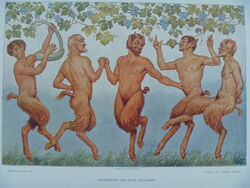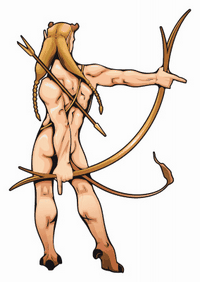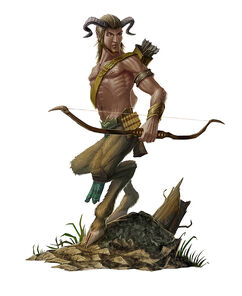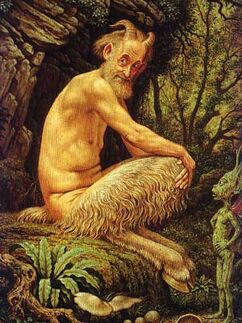| Satyr | |
|---|---|
 A jolly dance through the vineyard... | |
| Information | |
| Alternate Names/Spellings | (equine) Ipotane, (equine) Ipotayne, (pl) Satyri, (pl) Satyroi, Satyros, Satyrus, (old equine) Seilen, (pl. old equine) Seilenoi, (w. flute) Tityri, (w. flute) Tityroi, (w. flute) Tityros, (w. flute) Tityrus |
| Origins | |
| Alignment | Chaotic Neutral, Chaotic Good, Chaotic Evil |
| Element | Nature |
| Species | Chimera (Humanoid) |
| Appearance | Creature with humanoid torso, and ears and legs (and perhaps other features) of a horse, donkey, goat or ram... |
Origins[]
The Satyr is a creature with origins in Greek and Roman mythology, legend and folklore. Though it is notable that Homer is never known to have shared an account of the Satyrs' existence, they otherwise remain a famous (or infamous) staple within Greco-Roman mythology, legend and folklore, but among the best recognized Greek mythical creatures, even into the present day.
Though the Satyrs are all semi-divine, born of the gods, they do not all come from the same parents; some were born of the Nymph Hecaterides and the divine Dactyls; other groups were born from various other gods and spirits, including Hermes, Pan, Seilenos and the Oreades.
Names of specific Satyrs:
Ampelos
Astraios
Komos
Krotos
Lenai
Leneus
Marsyas
Pherespondos, Lykos, Pronomos
Poimenios, Thiasos, Hypsikeros, Orestes, Phlegraios, Napaios, Gemon, Lykon, Phereus, Petraios, Lamis, Lenobios, Skirtos, Oistros-
Seilenoi-
Seilenos-
Tityroi-
Appearance[]
A Satyr's upper body is that of a humanoid, typically with a skin color common among humans. Its face may appear entirely human, though some may have facial features of a horse, donkey goat or ram mixed in. In many cases, the head is surmounted by two sharp goat or ram horns that poke through coarse, curly hair. It may also have the ears of a horse, donkey, goat or ram, but it never has the full head of a horse, donkey, goat or ram.
Its most famous features, however, are its legs; these, of course, may be hind legs like a horse, donkey, goat or ram (including a horse/donkey's hooves, or cloven hooves like a goat/ram). The hair on a satyr's legs may be any color and pattern common among horses, donkeys, goats or rams. The same goes for their manes and/or horns, if they have them.
Typically, a Satyr has features all of the same animal nature (ie features of a horse, donkey, goat or ram), though such is not always the case). Yet, a young Satyr, before puberty, is distinguished from his older counterparts, in that he is indistinguishable from an ordinary human at all.
In fact, among the only things guaranteed about a Satyr's appearance, is that Satyrs are unilaterally male. Otherwise, a Satyr with all equine (horse/donkey) traits may also be referred to as an Ipotane, while an older Ipotane (wise, fat, elderly spirits who has never existed in a younger form) is referred to as a Seilen.

Behavior[]




The Satyrs romp through the forest...
Abilities[]


Satyr's are physically much Stronger, Faster ,and More Agile than humans. They can sense nearby magic, magical beings, and even Gods. Due to their horns they can ram into enemies with extreme force. Most Satyrs use Nature or Woodland Magic which they can use through reed pipes or some other form of outlet like a staff or they have Nature Magic in their body allowing them to have the innate ability of Nature Magic. Some Satyrs even use Bard Magic or Musical spell Casting. Satyrs other abilities allow them to Speak with and Communicate with Animals that are non magical and magical, Eat anything without pain or effect, Sense Nature and Nature Magic, and very little can even Transform into Animals and Trees.
